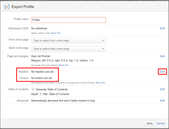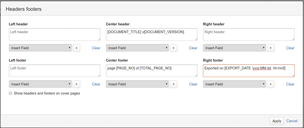We have been moved! Please follow the redirection link to our brand new documentation.
This feature is available only for PDF export
You can define custom headers and footers for the pages you want to export. These texts will be displayed on all pages in the appropriate header/footer field.
If you open the export dialog, select the Formatting tab you can see a summary of headers footers in the "Headers/Footers" section
To define headers or footers, just click the "Edit" link on the right in the "Headers/Footers" section:
A dialog will pop-up, where you can set the headers and footers:
You can enter any text or select some pre-defined fields from the drop-down lists below the text area by selecting it and clicking on the add button. Clicking the add button will insert the selected value into the field above at the cursor position.
Content in headers/footers are handled as html. This allows you to format the text using html formatting and styles and also to insert images. If you want to display xml/html in the header/footer, you have to manually escape it.
Changing the size of the headers and footers is coming soon.
Use the checkbox below the footers to show/hide the headers and footers on the cover pages.
Formatting dates
By default dates are shown in the format 'dd.MM.yyyy HH:mm', what produces the following output: 08.02.2017 01:02.
This can be changed by providing a custom date format after the field. The syntax for formatting is the following: [{FIELD_NAME} '{format string}'}].
Fields
The following fields are date fields, so you can use the formatting on them:
[DOCUMENT_LAST_MODIFIED]
[DOCUMENT_CREATED]
[EXPORT_DATE]
Format string
Format string is built up from formatting symbols
Here is a table about the formatting symbols and their meanings:
Symbol | Date or time component | Example |
|---|---|---|
y | Year | 2017,17 |
M | Month in year | 08 |
d | Day in month | 02 |
E | Day in week | Wed |
H | Hour in 24h format | 01 |
m | Minute | 02 |
s | Second | 03 |
Examples
Some examples using the date for last modified: 2017-02-08 01:02:03
Format | result |
|---|---|
[DOCUMENT_LAST_MODIFIED 'yyyy.MM.dd. HH:mm'] | 2017.02.08. 01:12 |
[DOCUMENT_LAST_MODIFIED 'dd/MM/yy EEEE'] | 08/02/17 Wednesday |
[DOCUMENT_LAST_MODIFIED 'E d. MMM yyyy'] | Wed 8. Feb 2017 |
[DOCUMENT_LAST_MODIFIED 'HH:mm:ss'] | 01:02:03 |
[DOCUMENT_LAST_MODIFIED 'H:m:s'] | 1:2:3 |
You can find more details about the formatting symbols, on the Customizing Formats in java page.
Inserting images into header/footer
To insert an image into the header or the footer you have to insert the html source in the header or the footer:
<img width=100px src="https://marketplace-cdn.atlassian.com/files/images/b13b3d13-9943-4692-ae49-40600ec0ad1b.png" alt="logo" border="0">
You may also insert the link of an image from a Confluence space, as long as the exporting user has read permissions for the page containing the image:
<img width=100px src="https://metainf.atlassian.net/wiki/download/thumbnails/70432009/profile-headers_footers.png?version=1&modificationDate=1501685540432&cacheVersion=1&api=v2&width=328&height=250" alt="logo" border="0">
Due to current technical limitations width must be given to resize the image. (height attribute is ignored)
Show cover page's title
By default Content Exporter does not export the title of the cover pages, however, it is possible to show it with the insertion of the following CSS code into our custom stylesheet:
.cover-page.front-cover .wiki-title {
display: block;
}
.cover-page.back-cover .wiki-title {
display: block;
}

